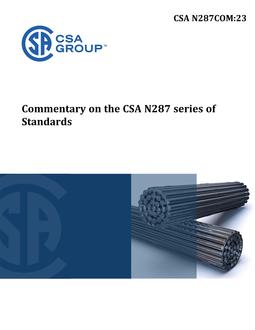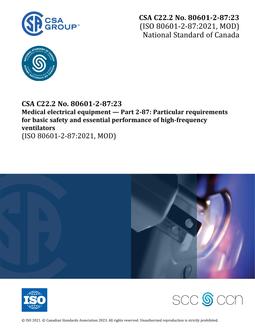
CSA N287COM:23
Preface
This is the first edition of CSA N287COM, Commentary on the N287 series of Standards. It reflects Canadian regulatory requirements, operating experience (OPEX) of the Canadian nuclear industry, and international practices. The CSA N287 Standards were originally written for CANDU® reactors but can be used for other concrete containment structures as applicable. This Commentary is directed only toward the requirements in the CSA N287 series of Standards published by 2022. The scope of this edition provides commentary on areas identified by users of the CSA N287 series of Standards which require additional clarity. This Commentary does not provide formal interpretations of the CSA N287 series of Standards. It has been written in informative (non-mandatory) language and is not intended to be adopted by users of the CSA N287 series of Standards or authorities having jurisdiction (AHJs) as additional requirements. Note: CANada Deuterium Uranium (CANDU) is a registered trademark of Atomic Energy of Canada Limited (AECL). The purpose of this Commentary is to provide background information concerning certain clauses and requirements in the CSA N287 series of Standards. This information can help the user clarify the context of the requirements in the CSA N287 series of Standards. The CSA N287 series of Standards consists of eight Standards. The objectives of each Standard are summarized as follows: – CSA N287.1, General requirements for concrete containment structures for nuclear power plants, specifies general requirements for the design, construction, testing, commissioning, and in-service examination and testing of concrete containment structures for nuclear power plants (NPPs) and is directed to the owners, designers, manufacturers, fabricators, and constructors; – CSA N287.2, Material requirements for concrete containment structures for nuclear power plants, specifies requirements for materials used for concrete containment structures; – CSA N287.3, Design requirements for concrete containment structures for nuclear power plants, specifies requirements for the design of concrete containment structures; – CSA N287.4, Construction, fabrication, and installation requirements for concrete containment structures for nuclear power plants, specifies construction, fabrication, and installation requirements for concrete containment structures for NPPs; – CSA N287.5, Examination and testing requirements for concrete containment structures for nuclear power plants, specifies examination and testing requirements that apply to the work of any organization participating in the construction, fabrication, or installation of concrete containment structures for NPPs; – CSA N287.6, Pre-operational proof and leakage rate testing requirements for concrete containment structures for nuclear power plants, specifies requirements for proof by demonstration, before first criticality, that the design and construction of concrete containment structures are satisfactory with respect to quality and performance as demonstrated by achieving the specified requirements of CSA N287.6, including commissioning leakage rate target; – CSA N287.7, In-service examination and testing requirements for concrete containment structures for nuclear power plants, specifies uniform requirements whereby, through systematic and periodic examination, the structural and leak-tight integrity of concrete containment structures can be assessed as demonstrated by achieving the specified requirements of CSA N287.7, including the operational leakage rate target; and – CSA N287.8, Aging management for concrete containment structures for nuclear power plants, provides aging management (AM) requirements for concrete containment structures for NPPs and is directed to the owners/operators, designers, manufacturers, fabricators, and constructors. Users of the CSA N287 series of Standards are reminded that the design, manufacture, construction, commissioning, operation, and decommissioning of nuclear facilities in Canada are subject to the provisions of the Nuclear Safety and Control Act and Regulations. This Commentary was prepared by the Subcommittee on the Commentary on the CSA N287 series of Standards, under the jurisdiction of the Technical Committee on Concrete Containment and Safety- Related Structures for Nuclear Power Plants and the Strategic Steering Committee on Nuclear Standards, and has been formally approved by the Technical Committee.
Scope
1.1 Scope
The scope of this Commentary parallels the scope of each Standard addressed. It covers all of the CSA N287 series of Standards, as shown in Clause 1.2. This Commentary refers to sources of material that were used during the formulation of some of the requirements in these Standards and can include a) concrete construction industry practice or experience; b) engineering or safety analysis; c) research or test programs; d) nuclear plant OPEX; and e) good engineering judgment. Within the various CSA N287 committees, minutes of technical committee (TC) meetings and requests for interpretation (RFIs) have also been surveyed to identify topics that merit coverage in this document. The development of each Standard through significant changes in the various editions is part of the history as explained in this Commentary.
1.2 Organization of content
Common elements and general background materials are captured in the main body of the Commentary, followed by Annexes, each of which corresponds to a specific Standard in the CSA N287 series as shown in Table 1. The editions listed include all amendments published up to the time the referenced edition was approved. The organization into these subject areas was primarily based on the specialized technical knowledge and expertise needed in these areas. For example, different expertise is typically required in material selection, design, analysis, construction, commissioning, examination, and testing. The objectives and responsibilities of the CSA TC are formally defined in its Terms of Reference. The TC considers the needs of all stakeholders (e.g., users, suppliers, AHJs, and licensees of CANDU NPPs). For each Annex, the main (i.e., level one) clause headings and the main clause numbers used in this Commentary correspond to those in the current published CSA N287 Standards. The numbering for subclauses (i.e., level two and beyond) in the Annexes in this Commentary does not necessarily correspond to those in the current published CSA N287 Standards, and additional subclauses or headings are added where the complexity of the subject warrants. Within each clause, the focus is on technical issues that have some background or merit some explanation beyond what the requirement in the Standard states. Not all requirements need to be explained, and aspects that are self-explanatory in the Standard are not repeated.
1.3 Interfaces
The CSA N287 series of Standards consists of eight Standards as listed in Table 1. Although these are eight separate documents, they are intended to be used in concert with each other as applicable, even where specific references are not provided. The users of one specific CSA N287 Standard are expected to be familiar with the requirements of other Standards of the CSA N287 series. Important inputs and interfaces exist with the Codes and Standards for general concrete structures, such as the National Building Code of Canada (NBCC), CSA A23.1/23.2, and CSA A23.3. As such, any inputs arising from such sources or use of materials in these industry Standards are identified if needed to explain the history or context. Typically, the CSA N287 series of Standards for concrete containment structures provide requirements that are above and beyond those defined in the CSA Standards that provide requirements for regular concrete structures such as CSA A23.1/A23.2 and CSA A23.3, which are referred to in the CSA N287 series of Standards, where applicable; however, the requirements from these Standards are not repeated. As such, the CSA N287 series of Standards builds on the requirements stipulated in the Standards for regular concrete structures. More explanation is provided in the Scope clause of each annex of this Commentary. The requirements that exist in other referenced CSA Standards (apart from the CSA N287 series) are not addressed in this Commentary. Only the history or rationale underlying the requirements in a specific CSA N287 Standard has been covered. A better understanding of the Commentary will be obtained if a copy of each CSA N287 Standard is available for reference. Accordingly, the relevant annex of this Commentary should be read along with the Standard in question. The CSA Standard, not the Commentary, always governs since it provides the formal requirements. Note: Several other CSA Committees (notably CSA N285 and CSA N286) have also published Commentaries as companion guides to their Standards.
1.4 Historical background
The requirements in the CSA N287 series of Standards are based on provincial and federal regulations and practices developed in the design, construction, inspection, and testing of CANDU NPP structures starting in the late 1970s and into the 1980s and 1990s. While the CSA N287 series of Standards are not intended to be “safety codes”, they have significantly contributed to the public safety and the successful start-up of the first generation of CANDU NPPs. As commissioning and operational experience have been gained, the Standards have evolved. Significant changes arising from this experience are identified in this Commentary.
1.5 CANDU containment design features
The Canadian nuclear industry is organized around different reactor concepts and has developed design, construction, examination, and testing rules specific to each type. In Canada, all nuclear reactors for power production are of the CANDU design at this time. There are both single-unit and multi-unit station configurations. Single-unit reactor building (RB) containment structures are of domed cylindrical structure design and are fully post-tensioned (basemat, wall, ring beam, and upper dome). These are designed to withstand a positive design pressure in case of an accident. Multi-unit stations share a common containment volume. The structures are built and commissioned in sections (using isolation bulkheads) from the vacuum structure outwards in stages. Multi-unit stations utilize a vacuum building to bring all of containment rapidly sub-atmospheric if there is a pressure rise after a loss of coolant accident (LOCA) in an RB. This greatly minimizes possible radionuclide release to the environment. Typically, CANDU containment structures have a relatively low positive design pressure. The containment structures of multi-unit vacuum building equipped stations also have a negative (gauge) design pressure and must be designed to minimize both out-leakage and in-leakage. Both single-unit and multi-unit containments of CANDU feature a dousing system to condense steam released from a break in the heat transport system, thereby limiting peak pressures. Due to design differences with light water reactors, Canadian standards were needed, both for CANDU reactors located within Canada and those located outside of Canada. One of the objectives of these Standards is to address technical requirements for those unique features of the CANDU concept not adequately addressed elsewhere. In some instances, it has been necessary for the Standards to clarify if the requirement applied only to new stations or existing stations in operation. Similarly, if new designs or concepts arise, it should be recognized that the requirements in these CSA N287 series of Standards were developed for CANDU pressurized heavy water reactor (PHWR) single unit and multi-unit containment structures with unique requirements and considerations. Hence the relevance and intent must be considered if elements are adopted for different types of containment structures in the future.
1.6 Regulatory
With the introduction of nuclear power and the development of the CANDU concept as Canada’s contribution to the power industry, the federal Nuclear Safety and Control Act was established to ensure that the use of nuclear energy in Canada does not pose undue risk to health, safety, security, and the environment. Consequently, the requirements in the CSA N287 series of Standards relate mostly to providing evidence to substantiate compliance with the relevant acts and regulations. Similarly, requirements of a technical nature are intended to ensure that the design, construction, and operation of the NPP will have the integrity needed to meet the objectives of the legislation. The CSA N287 series of Standards are intermediate-level documents positioned between the high-level regulatory requirements and the practices leading to the design, construction, inspection, and testing of containment structures. The CNSC, specifies regulatory and administrative requirements that cover containment structures in their regulations and regulatory documents. In the event of an inconsistency between regulatory documents and the requirements of the CSA N287 series of Standards, the regulatory documents prevail.
Product Details
- Edition:
- 1st
- Published:
- 07/07/2023
- ISBN(s):
- 9781488348075
- Number of Pages:
- 53
- File Size:
- 1 file , 1000 KB
- Product Code(s):
- 2430922, 2430922
- Note:
- This product is unavailable in Russia, Ukraine, Belarus


